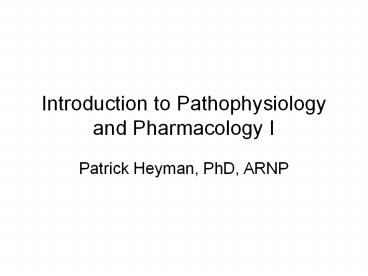Introduction to Pathophysiology and Pharmacology I - PowerPoint PPT Presentation
Title:
Introduction to Pathophysiology and Pharmacology I
Description:
Introduction to Pathophysiology and Pharmacology I Patrick Heyman, PhD, ARNP Important Concepts Pathology: Study of Disease Pathophysiology Patho: suffering, disease ... – PowerPoint PPT presentation
Number of Views:224
Avg rating:3.0/5.0
Title: Introduction to Pathophysiology and Pharmacology I
1
Introduction to Pathophysiology and Pharmacology I
- Patrick Heyman, PhD, ARNP
2
Important Concepts
- Pathology Study of Disease
- Pathophysiology
- Patho suffering, disease
- Physiology function of body
- Normal
- Disease
3
Development of Disease
- Etiology
- Pathogenesis
- Manifestations
4
Etiology
- Inherited or familial
- Congenital
- Toxic
- Infectious
- Traumatic
- Degenerative
5
Pathogenesis
- Natural History
6
Manifestations/Clinical Features
- Morphology
- Subclinical
- Symptoms
- Signs
- Lesion
- Sequela(e)
- Complications
- Resolution
7
Important Concepts Cont
- Drug, Prodrug
- Pharmacology
- Pharmacotherapeutics
- Effectiveness
- Safety Therapeutic Range and Index
- Selectivity
- Reversible action
- Predictability
- Administration
8
Important Concepts Cont
- Interactions
- Cost
- Chemical Stability
- Name Generic, Trade, Chemical, Experimental
- Therapeutic Objective
9
Intensity of Drug Response
- Administration
- Route
- Medication errors
- Patient Compliance
- Pharmacokinetics
- Absorption
- Distribution
- Metabolism
- Excretion
10
Intensity of Drug Response
- Pharmacodynamics
- Drug-receptor interaction
- Patients functional state
- Placebo effects
- Individual Variation
- Physiologic variables
- Pathologic Variables
- Genetic variables
- Drug interactions
11
Nursing Responsibilities (the pitcher and the
catcher)
- Pre-administration assessment
- Baseline data
- Stratification of risk
- Planning and Implementation Dosage and
Administration - Five Rights
- Understand the correct dosing range
- Appropriate safety measures
12
Nursing Responsibilities
- Evaluating and Promoting Therapeutic Effect
- Evaluating Therapeutic Response
- Promoting compliance/adherence
- Implementing non-drug measures
- Minimize Adverse Effects
- Minimize Adverse Interactions
- PRN decisions
- Managing Toxicity
- Patient education
13
Approval of Drugs Drug Legislation
- 1906 A drug must be what it says it is
- 1938 Drugs must be tested for safety and
approved by FDA - 1962 Drugs must be effective for what they
claim testing procedures - 1970 Controlled Substances Act
- 1992 Relaxed procedures for Cancer and AIDS
drugs - 1997 FDA Modernizing Act
- Fast track for AIDS, cancer, and other life
threatening conditions - Manufacturers must give 6 month notice before
discontinuing a drug - FDA can require testing in children
- Clinical trial database
- Drug companies can provide physicians with
articles on off-label uses
14
Drug Approval Process
- Preclinical testing
- Toxicity
- Pharmacokinetics
- Possible Useful Effects
- Clinical Testing (in Humans)
- Phase I Normal subjects metabolism and side
effects - Phase II Patients, therapeutic utility and
dosage range - Phase III Patients safety and effectiveness
- Conditional Approval
- Phase IV Posmarketing Surveillance
- Limitations of Process
- Women and children
- Failure to detect all adverse effects
15
Drug Names
- Chemical (N-acetyl-para-aminophenol)
- Generic (acetaminophen)
- International name (paracetamol)
- Trade Name (Tylenol)
- Easier to remember
- Emotional allusions
- Multiple trade names for one drug
- Same trade name with more than one product
16
Availability
- OTC
- Legend
- Scheduled
- V Least dangerous addictive Ambien
- IV Less dangerous addictive
- III dangerous addictive hydrocodone, codeine
- II highly dangerous addictive morphine,
cocaine - I dangers outweight benefits marijuana, heroin
17
Ways to cross a cell membrane
- Channels and Pores
- Transport systems
- Direct penetration of membrane must be lipid
soluble - Polar molecules
- Ions
18
Pharmacokinetics
- Absorption movement of drug from site of
administration to blood - Rate of dissolution
- Surface area
- Blood flow
- Lipid solubility
- pH partitioning
- Distribution
- Metabolism
- Excretion
19
Absorption Routes of Administration
- Enteral gastrointestinal (mouth, rectum, tubes)
- First Pass Effect
- Parenteral injection (IM, IV, SC)
- Topical
- Transdermal
- Inhaled
- Vaginal
20
Drug Distribution
- Blood flow to tissues
- Exiting the Vascular system
- Typical Capillary Beds
- Blood-Brain Barrier
- Placental Drug Transfer
- Protein Binding
- Entering Cells
21
Metabolism
- Hepatic Drug-Metabolizing System
- P450 cytochrome system
- hepatic microsomal enzyme system
- Therapeutic Consequences of Drug Metabolism
- Accelerated Renal Drug Excretion
- Drug Inactivation
- Increased Therapeutic Action
- Activation of prodrug
- Increased or Decreased Toxicity
22
Metabolism
- Considerations
- Inductions of P450 system
- Competition between drugs
- First Pass Effect
- Nutritional status
23
Drug Excretion
- Removal of Drug from the body (urine, sweat,
bile, saliva, breast milk, lungs) - Renal Drug Excretion
- Glomerular Filtration
- Passive Tubular Reabsorption
- Active Tubular Secretion
- Breast Milk
- Bile
24
Pharmacodynamics
- Dose Response Relationships
- Maximal Efficacy
- Potency
- Drug Receptor Interactions
- Receptor-Types
- Selectivity
- Theories
- Mode of Action
25
Dose Response
26
Maximal Efficacy
27
Potency
28
Receptor Types
- Cell Membrane-Embedded Enzymes
- Ligand-Gated Ion Channels
- G Protein-Coupled Receptor Systems
- Transcription factors
- Selectivity
- Lock and key
29
Mode of Action
- Agonists
- Antagonists
- Partial Agonists
- Regulation of Sensitivity
30
Therapeutic Index
31
Drug Interactions
- Drug-Drug Interactions
- Intensification Effect and/or Adverse Effects
- Reduction
- Food-Drug Interaction
- Absorption
- Metabolism
- Toxicity
- Action
- Food-Herb Interactions
32
Adverse Effects
- Side Effect
- Toxicity
- Allergic Reaction
- Idiosyncratic
- Iatrogenic
- Physical Dependence
- Carcinogenic
- Teratogenic
33
Medication Errors
- Any preventable event that may cause or lead to
inappropriate medication use or harm - 13 types of errors (see Table 7-3, pg 67)
- Causes of Medication Errors (90)
- Human factors
- Performance deficits (30)
- Knowledge deficits (14)
- Miscalculation of doses (13)
- Communication Mistakes (15) handwriting,
confusing abbreviations, decimals, apothecary vs.
metric units - Name Confusion































